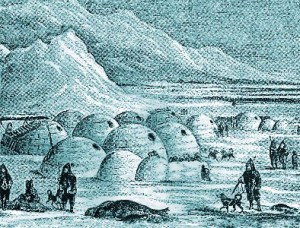CSU scientist and author of The Paleo Diet, Loren Cordain responds to U-C Davis Scientist and co-author of the New Atkins, Steve Phinney’s discussion on Pemmican. This interview includes Loren’s opinion that saturated fats DO increase plaque in the arteries. However, Loren says, this only becomes very hazardous when saturated fats are eaten in combination with grains, beans, dairy, high-sugar foods or other foods that tend to increase inflammation. Cordain says the combination of saturated fats and inflammatory foods such as grains is a deadly formula for a heart attack.
Listen to Loren Cordain (15 minutes)
Here are articles Loren references in this discussion:
Artery Plaque in Pre-Westernized Inuit
Research on Heart Attacks in Monkeys
Interview with Loren Cordain about Steve Phinney’s discussion of Pemmican.
I am impressed with Steve Phinney’s earlier work, that was clinically based. I think he’s got some good ideas. But there are parts of this, particularly the scurvy situation, which I’m a little bit skeptical about.
Anything else like that? I’m curious because you’re one of the few experts in the world on Paleolithic diets. Steve Phinney’s focusing in on a particular kind . . .
I’m very familiar with pemmican. I’ve got all the pemmican stuff forever. Stefansson tried to get a grant in World War II from the U-S army to feed the troops pemmican.
I’m not saying that pemmican isn’t a healthy food. It’s probably an expedient way to provide calories over a North American winter. It’s a very great way to store these things. An all pemmican diet, I don’t think is a healthy diet for a number of reasons. If you only eat pemmican, I think you’ll become osteoporotic. You won’t get any vitamin A. If you eat only pemmican, you will promote atherosclerosis. So I just bring to you one paper that I’d like you to distribute. That paper is published in an obscure journal, the Texas Heart Institute Journal in 1993. So nobody’s read it, because you can’t get it on Medline. What this guy did, he was a physician, an MD PhD by the name of Zimmerman. Zimmerman was a pathologist, and he was lucky enough to be in Alaska when a 400 AD, so we’re talking 1600 year old, frozen Inuit mummy was recovered. He did an autopsy on this, and he sectioned the coronary arteries. So this is 400 AD. These people had never seen white people. They had only eaten what Steve Phinney had suggested people eat–fat and protein–and significant atherosclerosis in a 53 year old Inuit woman, on pathology. That wasn’t just the only case. He then was privy to another group of frozen Eskimo bodies that were recovered in Barrow, Alaska, and these people date to about 1520 AD, so just slightly after the time Columbus had discovered America. Once again, no influence of Western civilization. So presumably, they were living at Barrow, 60 degrees north, they were eating meat and fat their entire life. They might get a little bit of berries sometime in the summer. Extensive atherosclerosis was in the older woman, who was 30. All three of them were osteoporotic. They were severely osteoporotic on that type of diet. So you can give this to people who claim that all we need to eat is meat and fat.
And then I’ll take this one step further, and here’s another obscure paper because we’re no longer allowed to perform these experiments in primates in which we feed them atherosclerotic diets and try to induce an MI.
That means a heart attack. A Myocardial Infarction. An MI.
In 10 rhesus monkeys and two other monkeys, they were able to induce myocardial infarctions, and electrocardiographic abnormalities, unexpected and relative sudden death in these non human primates are also consistent with signs that are frequently observed in humans. This is an obscure paper that absolutely needs to be addressed by the unlimited saturated fat type groups.
Let’s see what the response of people like Steve Phinney, Eric Westman and Jeff Volek would be. They have a new book out, the Atkins diet book. There’s some difference of opinion between the three. They’re all top-notch scientists.
I agree. I respect all these people. I respect all the scientists. I’m on record stating that saturated fats are not uni-dimensionally responsible for cardiovascular disease. They represent a risk factor. And the risk factor of saturated fats can be small. In the context of a Paleolithic diet I don’t believe that high stearic acid levels which is 18-O, is atherogenic. I don’t believe high 12-O or 14-O is atherogenic because they occur in such small concentrations.
Palmitic acid is atherogenic. And there’s not an experiment in humans or animals or tissue to show that it doesn’t down regulate the LDL receptor. This is a point that is never addressed in Gary Taubes’s book or Eric Westman’s articles, or Ron Krauss. You need to address the down regulation of the LDL receptor. That controls the flux of oxidized LDL in and out of the intima.
So on a molecular basis, you can’t deny this information. Now, how relevant is that information under the umbrella of a high carbohydrate diet? A high carbohydrate diet combined with a high saturated fat diet is even worse.
And that’s something that it seems like all you researchers tend to agree on. Steve Phinney did mention that he thinks there are islands of safety in many ways of eating.
Yes. I would agree.
You would agree with that?
Yes. I think you can tend to eat a high saturated fat diet. A high animal food diet. You’re going to be at risk for osteoporosis, Vitamin A deficiency and some other factors, if you don’t eat some plants in your diet. Now if you eat liver, the Vitamin A is a non-issue. But if you only ate muscle meat and fat, then it’s not going to work.
If you eat organ meats like traditional people consumed then you’re going to be in pretty good shape. The osteoporosis does not clear out, and you can see that in these papers here.
If we believe the results of this pathology, that we have atherosclerosis in people who never consumed carbohydrate, always ate a high fat, high protein diet, this atherosclerosis who always consumed a high fat, high protein diet. Then the question comes up, did they ever suffer a fatal MI. My opinion is that they probably didn’t.
Even though they had hardening of the arteries, plaque, they might not have had the inflammatory conditions that cause heart attacks.
Bingo, there you go!
In that way, you and Steve Phinney might agree.
I’ve always stated that, and I’ve been misquoted so often on this saturated fat issue and atherosclerosis. The devil’s in the detail. So I believe these Inuit women who had never been exposed to Western Food did indeed have atherosclerosis.
They had a lot of plaque in their arteries, they had hardening of the arteries, but did that mean they had a heart attack?
No! What kills you is not plaque in the arteries. What kills you is the rupture of the plaque. What causes the rupture of the plaque . . . because I think what happens is that atherosclerosis goes forth. Our bodies wall it over, we wall it out, and the lumen of the artery actually expands to compensate for the thickness of the intima. What kills us in the Western world, we have this atherosclerotic process going on, like we have in these Inuit. But in contrast to them, we have a pro-inflammatory diet. If you took these 1600 year old Inuit women and fed them bread along with their high fat diet, I would be almost certain that you would see myocardial infarctions.
Inuit women in the time of the transition to Western food were eating both their high animal fat foods and also Western sugars and starches, and all of a sudden, they had obesity, they had heart disease, they had diabetes.
That’s right. We are actually exploring this, and you can mention this to Eric and Steve Phinney and all these folks because I respect them all. We believe that wheat upregulates metalloproteinases. It upregulates metalloproteinase 2 and metalloproteinase 9. If you look at the final dissolution of that fibrous plaque, what causes that fibrous plaque to rupture– it’s made out of collagen and smooth muscle and cholesterol. What causes it to rupture is metalloproteinases. They up-regulate and degrade the collagen, and when the fibrous cap breaks, that is the event that kills you. We believe elements in the Western diet, including Wheat and corn and grain and legumes and high glycemic load carbohydrates, these upregulate the enzymes that directly cause the rupture of the fibrous cap.
So that spaghetti meal could be what triggers the heart attack.
Right. But to unequivocally say that saturated fats do not cause atherosclerosis, is sheer folly. We know that they do. We awarded the Nobel Prize in medicine to Brown and Goldstein for saying that Palmitic acid down regulates the LDL receptor. Unless we’re going to take that Nobel Prize back, you cannot deny that information. So, I would like to hear a response of how in the world LDL receptors are not down regulated by palmitic acid.
Let’s see if we can get a response from Steve Phinney on that because I believe he’s an expert on saturated fats.
Let’s do it!
One other thing these scientists said is that, a person should not mix and match diets, even if there are islands of safety between ways to eat, and they have health potential in that style of eating. If one day somebody eats the fruit and vegetable diet of the Hawaiians and the next day, they eat the Pemmican diet of the plains Indians, that might be a very bad idea. What do you think?
We don’t have any randomized controlled trials of that idea. We only have four randomized trials of Paleolithic diets right now. These are all very recent. When you start mixing and matching and talking about a Hawaiian diet and an Inuit diet and this and that. Long after I’m gone, we’re going to be looking to have the data speak for itself. So we need good experiments at good laboratories, based on good hypothesis.
That opinion about, ‘Don’t mix and match diets.’ That comes from the need for the cells to be adapted to either burning fat or burning sugar. It’s hard for them to do both, and adapting to fat-burning can take a cell several days to settle into.
You’re right, metabolic issues matter, and also looking at glycation end products and factors like that.
And upregulation of a hormone such as insulin and the need for cells to be insulin sensitive.
I don’t know that you’re going to find a huge argument about glycemic index and insulin resistance and high glycemic load carbohydrates. I think there are a few stragglers hanging on to the low-fat, high-carb diet.
Such as the American Diabetes Association, the American School Nutrition Program? A few stragglers like that.
Unfortunately, those people are politically well positioned. But, we’re getting the soft drinks out of the school environment. We realize that trans fats are not good for us, and junk food potato chips are not healthy foods. That kind of collective wisdom will be for the next generation. The people that are being taught right now in their twenties. They have to read these papers. These papers are what we teach in the universities right now. The students are taught to critically think. They need both sides of the argument. It’s very easy to get caught up by your own ideas. Good scientists don’t do that. Good scientists critically evaluate both sides of the argument, and good scientists also change their belief system when the data shows otherwise.
Thanks for being an astute critic.
I talked with a couple of your students. They said your ideas are really intriguing, but could it really work as a way to feed the world?
I’ve never said it’s a way to feed all the world’s people.
It’s ironic. We can no longer eat the diet to which we’re genetically adapted. Having said that, middle class people who are middle aged in the U-S. These are the ones suffering the most from these diseases of malnutrition. And these people can afford to eat whatever they want. That is the crucial caveat. For the world’s population, unfortunately, we’ve walked down a path of total reliance of cereal grains that we can’t reverse. So yeah, you can’t feed the world without cereals grains and legumes.
Perhaps we can reduce their damaging effect of how we provide them, how processed they are, what they’re served with.
I don’t know that we can. Wheat is consumed in every country, every place in the world, and wheat causes this leaky gut that leads to this inflammatory response. So every person on the planet who regularly eats wheat probably at some point in their life, particularly as they age, has chronic inflammation.
Yet another puzzle to figure out. How to feed the planet.
Genetically we can probably make wheat without gliadin. But if you take all these anti nutrients out, then the insects have a feast and they destroy the crops.
Well, one puzzle after another.
Yeah.







13 comments for “Loren Cordain – Caution: Saturated Fats – Disaster with Grains”